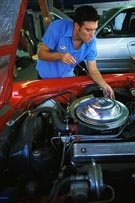 Without oil breakdown, contaminants, or auxiliary equipment failures there would be little need to monitor the condition of lubricating and hydraulic oils in operating equipment. Unfortunately, Murphy lives: things can and frequently do go drastically wrong.
Without oil breakdown, contaminants, or auxiliary equipment failures there would be little need to monitor the condition of lubricating and hydraulic oils in operating equipment. Unfortunately, Murphy lives: things can and frequently do go drastically wrong.
The breakdown of the base lubricating oil, its additive package or the included detergents is the primary cause of lubricant replacement. Lubricating oil health is also affected by wear contaminants from internal moving parts such as the rings, bearings, and hoses. Combustion by-products and gaps in the air system allow debris to enter the oil system, which can have a very serious effect on lubricating oil quality. High concentrations of airborne dust such as found in Southwest Asia, quickly turn lubricating oil into sludge. Fuel leaks, coolant leaks or equipment temperature problems can also affect oil characteristics.
All these failures impact the viscosity of the oil. Contamination from wear or debris increases the viscosity. Incomplete combustion, fuel leaks, coolant leaks, overheating, additive loss and detergent breakdown tend to decrease the oil viscosity before complete failure cooks the lubricant causing its viscosity to increase. Viscosity also indicates whether the correct oil is being used for engine lubrication. Early detection of any of these conditions allows the issue to be addressed before it becomes a problem.
As indicated in this paper, viscosity is a good early indicator of certain aspects of oil health, and with other indicators can be effectively used in an early detection and pre-treatment program to head off potential disasters.
To fully capitalize on this, viscosity must be monitored on-engine or on-equipment. Such a sensor must be fundamentally rugged, accurate and reliable. It can not cause more trouble than it is worth: the sensor must be self-cleaning so that it works in the background and is essentially trouble-free throughout the lifetime of the equipment. It must be able to measure temperature and correlate it with viscosity so that the impact of temperature fluctuations on viscosity can be normalized. Significant changes in temperature are typical in the operating cycles of engines and other equipment, and viscosity changes as temperature changes regardless of the condition of the fluids.
This paper, written by Rob Kasameyer and Curt Felix of Cambridge Viscosity, demonstrates how real-time oil viscosity measurement and trending can identify lubricant problems well before they cause equipment damage or failure.
Known for innovation in viscosity measurement and control, Cambridge Viscosity specializes in the industry's most accurate, reliable, and easy-to-use viscometers for research laboratories and process environments.
Cambridge Viscosity, Inc.
50 Redfield St, Suite 204
Boston, MA 02122 USA
781 393-6500
Email: Sales@CambridgeViscosity.com